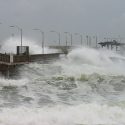Using satellites to enhance air quality understanding
The first late winter thaws bring puddles, mud, and a promise of spring in the air. But there may also be something less wholesome in the air — very high levels of air pollution.
“The first few warm days, when all the snow is beginning to melt, are often the worst particulate matter days of the whole year,” says Tracey Holloway, director of the Center for Sustainability and the Global Environment (SAGE) at the University of Wisconsin–Madison’s Nelson Institute for Environmental Studies and an expert on air quality.
Though air quality monitoring programs have noted the phenomenon for some time, it is not known what drives the high levels of nitrate particles. Perhaps trapped pollution is released from melting snowbanks, or the weather conditions that lead to early thaws also trap emitted airborne particles.
This is exactly the type of question that Holloway is poised to answer thanks to a new five-year, $750,000 grant from NASA, announced earlier this month and aimed at applying satellite data to air quality issues. A research team composed of Holloway, UW–Madison atmospheric and oceanic sciences professor Steven Ackerman, and Bart Sponseller of the Department of Natural Resources will focus their efforts on using satellite data to study connections between energy, transportation, climate, and air pollution, especially nitrogen oxides and fine particulates such as soot.
“Over the past 10 years or so, the ability of satellites to tell us about air quality at the Earth’s surface — where transportation and power plants are emitting and where people are living — has really advanced,” Holloway says.
As lead investigator of the new grant, Holloway is part of a new NASA Air Quality Applied Science Team, whose 19 members from across the country will meet regularly to guide and coordinate research goals and discuss progress.
A second member of the team also hails from Madison. R. Brad Pierce, a physical scientist with the National Oceanic and Atmospheric Administration who is housed on campus at the Cooperative Institute for Meteorological Satellite Studies (CIMSS), will focus on using satellite data to improve national air quality forecasting on both regional and global scales.
The researchers say that the big-picture view afforded by satellites can fill in gaps left by ground-based air quality monitoring, while ground measurements will help test and validate satellite-based scientific models.
“There are new opportunities to use satellite data to answer questions that are relevant to public policy and public health and air pollution management. This team is being put together to move those connections forward and identify how data from NASA satellites — which are a major national investment — can be used with the greatest benefit,” Holloway says.
Instruments on the satellites measure solar radiation absorbed and emitted by different gases and particles. Those signals can then be combined and translated into estimates of what is actually in the air.
NASA satellite data is all publicly available online but can be difficult to work with and analyze, especially for those not accustomed to it, Holloway says. One project goal is to help make that data more accessible and easier to use for agencies, policymakers, transportation consultants, energy analysts, and others.
“Up until now, all our air quality data has been from ground-based monitoring,” says Sponseller, the section chief for the DNR’s air monitoring program. “Now we’ll be able to look down from space to get a three-dimensional view of the atmospheric interactions that influence air quality.”
UW-Madison has a long history of expertise in satellite technology and data acquisition, analysis, and display, beginning in the 1960s with Vernor Suomi and Robert Parent, says Ackerman, who is director of CIMSS. The campus is the birthplace of the field of satellite meteorology and has housed CIMSS since its founding in 1980. Last summer that partnership was renewed through at least 2015, which will help ensure that the Wisconsin groups have access to the best possible resources.
The occurrence of high air pollution days in the late winter and early spring in the Midwest is one topic Holloway’s team may pursue. They also hope to loop in ongoing research on air pollution patterns across space and time, including emissions from freight and power plants, and couple the satellite data with ground-based information.
The Air Quality Applied Science Team will hold its first teleconference next month to begin shaping research directions ahead. It’s a great opportunity to work with other leading scientists in the field to align multiple research approaches toward similar goals, Holloway says. “Clean air is something everyone can agree on.”

